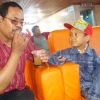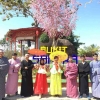The beginning of the arrival of ethnic Balinese to Lampung was motivated by the transmigration carried out by the government, the disaster of the eruption of Mount Agung which had destroyed the residence of ethnic Balinese in Bali, and their own desire to move. Based on this fact, ethnic Balinese tried to find a more suitable place to live in an effort to sustain their family life. In 1963 the government again held a second transmigration program which was one of the factors behind the ethnic Balinese transmigrating to the South Lampung area, considering that the South Lampung area had fertile natural conditions and was suitable for agricultural and plantation development. This is in line with the transigration program launched by the government in order to spread the population evenly in Indonesia in general. due to the eruption of Mount Agung in Bali. This second wave of transmigration occupied the South Lampung area which at that time was still a wilderness. During the New Order period, transmigration was a national program created by the government at that time to overcome population problems in Indonesia.On December 12, 1950, the Indonesian government for the first time after independence, moved its population of 23 families to the Lampung area. Later it was commemorated as the day of Transmigration Service. Transmigration at that time aimed to equalize the population, reduce unemployment, improve the welfare of transmigration residents, increase the country's economic growth and protect the territory of the Republic of Indonesia. When natural disasters occurred, namely the eruption of Mount Merapi and Mount Agung in 1963, the government of the Republic of Indonesia again sent people to transmigrate. The long-term development program phase 1 in the new order era succeeded in moving 1.4 million heads of families or as many as 7 million people from Java, Bali and West Nusa Tenggara to Lampung. After the transmigration held by the government, several ethnic Balinese people from Nusa Penida made independent transmigration to Lampung.Ethnic Balinese in South Lampung were also given 11 hectares of land, which was then named Balinuraga Village. Unlike other transmigrant areas, the Balinuraga transmigrant area was completely inhabited by Balinese ethnic groups from Nusa Penida. Due to the tenacity of the Balinese, the village is improving. However, the social inequality between Balinuraga village, which is inhabited by Balinese, and Agom village, which is inhabited by Lampungese, has led to various kinds of friction conflicts, resulting in the 2012 conflict, which was caused by misunderstandings between the two ethnic groups and old grudges. After the conflict, the two ethnicities made a peace agreement and apart from all that there was one change that was no less important than the four changes that occurred between the two parties, especially for Balinuraga Village, namely changes in religious activities. Regarding religious changes after the conflict in October 2012, which is commonly called Lampung berdarah, the religious activities of the Balinuraga community were disrupted, namely during the death ceremony (ngaben). The Balinuraga community at that time was not allowed to cross the Agom Village road when they wanted to perform the death ceremony (ngaben), so the Balinuraga community was forced to take a longer detour to carry out the ceremony.
Although there are no researchers who have written about this, according to the results of observations made by researchers, it is known that in South Lampung two villages have had conflicts, namely Balinuraga village and Agom village in 2012. After that, the two villages resolved the problem peacefully. There have been various changes made by both parties. both parties, even in terms of communal has also been well established as evidenced by the friendship between the leaders of the two has been done a lot. From a cultural point of view, it has also improved and this is evidenced by the Rembuk Pekon event which is attended by both ethnics and the last from a structural point of view, the network between traditional leaders in strengthening Lampung and Bali customary structures is getting better, and is fully supported by the local government. The strengthening of these customary institutions serves to channel the interests of its members.
So there is a force that is deliberately fostered to become a communication space between local elites from both Lampung and Bali, for example often staying in touch both verbally and directly in contact with the elites of the Balinese, Javanese, Lampung and others in South Lampung in particular. In the case of the conflict between Agom and Balinuraga, it is illustrated that the conflict strengthened relationships within each group. For example, in Agom village, although the conflict highlighted was a conflict involving two different ethnic groups, Lampung and Bali. However, the Agom community itself is not only from the local community that strengthens its relationship, Javanese and other ethnic communities in the area also blend into one bond. As one of the Javanese people in the village said, there is no longer a separation between ethnic groups. In fact, there has been a cultural exchange between Lampung and Java, as evidenced by the number of residents who master the language of each ethnic group.
The 2012 conflict actually led to many perspectives on the actual events that occurred behind the conflict. Not only in Agom Village, the strengthening of relationships within the community also occurred in Balinuraga Village at the youth level. then Balinuraga youth lived in compartmentalized groups. However, with the 2012 conflict, Balinuraga youth are now more united in Balinuraga ties. Not only that, the impact of the conflict also changed the behavior of the Balinuraga village youth. Initially, youths who were arrogant must now be more able to restrain themselves from making trouble.
Reference:
Alie, Humaedi M, et.al. "Kegagalan Akulturasi Budaya dan Isu Dalam Konflik Lampung", Jurnal Analisa. Vol.20. No.02, Desember 2014.
Desi, Mediawati, "Konflik Antar Etnis dan Upaya Penyelesaian Hukumnya", Jurnal Khazanah Hukum. Vol. 1. No.1, Desember 2019.
Desike, Vivin, et al., 2017. "Konflik Antar Masyarakat Etnis Jawa di Desa Sukaraja Tiga dan Masyarakat Etnis Lampung di Desa Gedung Wani Kecamatan Marga Tiga Lampung Timur", Jurnal of Social Science Education.
Kurniadi, Akbar, et.al, "Transformasi Konflik Sosial Antara Etnis Bali dan Lampung Dalam Mewujudkan Perdamaian di Balinuraga, Kecamatan Way Panji, Kabupaten Lampung Selatan", Jurnal Pertahanan dan Bela Negara.
Putro, Yahya Aryanto, et. Al. 2017. "Konflik Rasial Antara Etnis Tionghoa Dengan Pribumi Jawa di Surakarta Tahun 1972-1998", Journal of Indonesian History.
Sagita, Winar, et.al. 2016. "Konflik antar Etnis dan Upaya Penyelesaian Hukumnya", Jurnal Ilmiah Mahasiswa Sejarah.
Hartoyo. 2012. Memutus Mata Rantai Konflik di Lampung. Bandar Lampung: AJI Bandar Lampung
Utami, Anisa. "Resolusi Konflik Antar Etnis Kabupaten Lampung Selatan (Studi Kasus: Konflik Suku Bali Desa Balinuraga Dan Suku Lampung Desa Agom Kabupaten Lampung Selatan)" (Skripsi). Semarang: Universitas Diponegoro.











